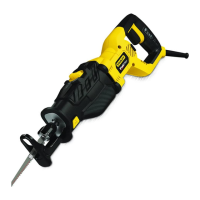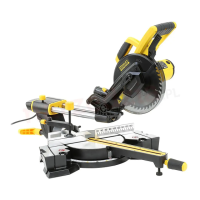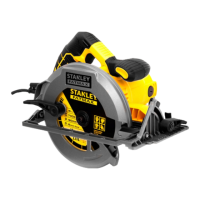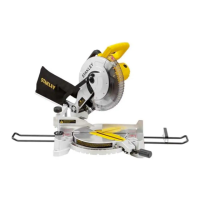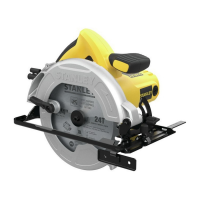Any repair required on this laser product should be performed
by authorised service centre personnel.
Plunge cutting (g.J)
u Press button(10).
u Switch on the tool.
Warning! The tool should run at full speed before the blade
enters into the workpiece.
u Tilt tool forward with line-of-cut indicator (20) lined up with
desired line of cut marked on the workpiece. Gradually
move tool forward.
Warning! Never pull tool backwards.
Using the parallel guide (g.K)
u For making exact cuts along a workpiece edge.
u Can be inserted in either side of foot.
Adjusting parallel guide
u Loosen knob (5)
u Adjust to desired cutting width by using parallel guide
scale (use line-of-cut indicator (20) as 0-reference).
u Tighten knob (5).
Tips for optimum use
u Only use sharp saw blades of the correct type and size
(g. L).
u Use hardened steel saw blade (17) for cutting wood,
aluminium, plastic and all sorts of laminated wood
u Use diamond saw for (16) cutting ceramics and tiles
u Use carbide-tipped blade (18) for wood and plastic only
Cutting large panels (g. M)
u Support panel close to the cut either on oor, table or
workbench.
Warning! Set cutting depth so that you cut through panel
and not through support.
u In case parallel guide does not allow desired width of cut,
clamp or nail straight piece of wood to workpiece as a
guide, and use the right side of the foot against this guide.
Splinter-free cutting
u Always face the good side of the workpiece down - fasten
a straight piece of wood on the workpiece by means of 2
clamps.
Cutting particularly tough or abrasive
materials
Soft sheet metal
u Always set the depth adjustment to at least 1 mm deeper
than the material thickness to avoid the blade riding up
over the surface. Scrap material is required underneath
the work surface.
u Remove burrs and rust as these impede the feed across
the material.
u Thick beeswax (furniture polish) applied to the base plate
of the tool makes metal cutting easier.
u Only suitable for cutting brass, copper, lead or aluminium.
u Every 2 minutes of metal cutting should be followed by a
rest of at least 3 minutes.
Ceramic tiles, slates etc
u Only use a blade specically designed for this purpose.
u Always use with a suitable vacuum cleaner or dust
extractor connected as the dust can be hazardous to the
operator and prevent the guard operating correctly.
Plasterboard:
u The plunge saw is only recommended for making oc-
casional cut outs in plasterboard and always use it with a
suitable vacuum cleaner or dust extractor connected. The
dust can prevent the guard operating correctly.
u Conventional tools such as keyhole saws or knives gener-
ally give excellent results, though the plunge saw can be
used if a particularly neat, dust free cut is required or if
there is a danger of cutting pipes or cables.
Maintenance
Your Stanley Fat Max corded/cordless appliance/tool has
been designed to operate over a long period of time with a
minimum of maintenance. Continuous satisfactory operation
depends upon proper tool care and regular cleaning.
Warning! Before performing any maintenance on corded/
cordless power tools:
u Switch off and unplug the appliance/tool.
u Or switch off and remove the battery from the appliance/
tool if the appliance/tool has a separate battery pack.
u Or run the battery down completely if it is integral and then
switch off.
u Regularly clean the ventilation slots in your appliance/tool/
charger using a soft brush or dry cloth.
u Regularly clean the motor housing using a damp cloth.
Do not use any abrasive or solvent-based cleaner.
Warning! If any of the following events occur during normal
operation, the power supply should be shut off at once and
tool thoroughly inspected by a qualied person and repaired
if necessary:
u The rotating parts get stuck or speed drops abnormally
low.
u The tool shakes abnormally accompanied by some
unusual noise.
u The motor housing gets abnormally hot.
u Heavy sparks occur around the motor area
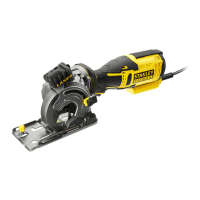
